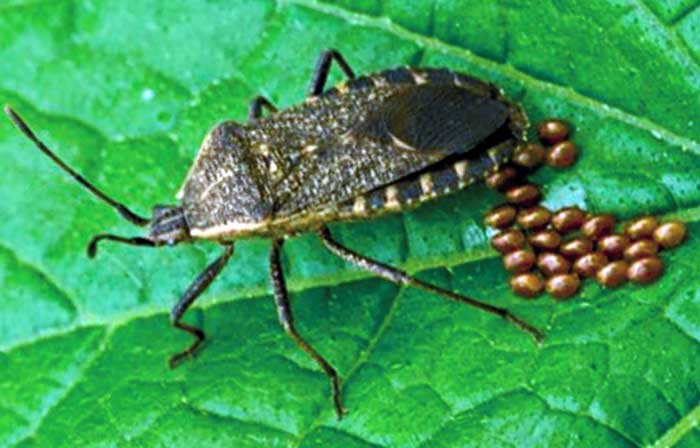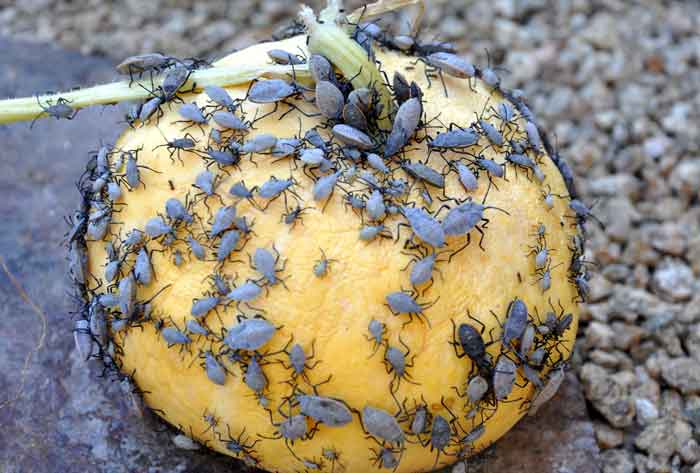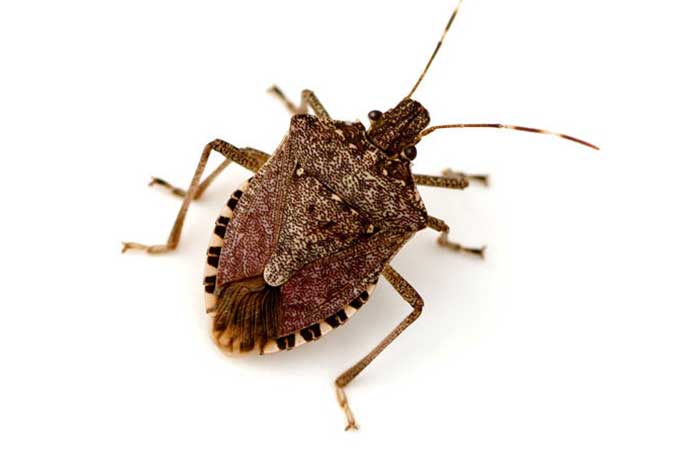Squash bugs are insects which cause so much destruction in your garden. These bugs are prevalent throughout the United States. Here is what they are and how they look like, ways of getting rid of them; both naturally and by use of chemicals and possible preventive measures.
Table of Contents
Squash Bugs -Pictures &Life Cycle
Squash bugs are bugs found on squash plants. These bugs have their origin in Central America. The bugs can also be found on pumpkins. For that reason, squash bugs are described as a serious squash and pumpkin pests, and a lesser pest of cucumbers and melons.
The damage of squash bugs is majorly limited to cucurbit family. In most cases, squash bugs are confused with stink bugs because of the similarity in their appearance. This will be discussed later in the article.
To distinguish squash bugs from any other bugs, you need to clearly understand how these bugs look like so that you can easily identify them. The body of squash bugs appears to be armor plated. However, it is covered by tiny hairs which act as protection of the bugs as they move around the parts of a plant.
Squash bugs are quite large since they measure over ½ an inch in length. These bugs have a brown body or sometimes, a gray body. The back of squash bugs is flat with the edges and lower sides of the abdomen having orange stripes. The overlapping nature of the wings makes an X on the back of insect.
Although these bugs can fly, they prefer walking around on plants. It is the nymphs (young squash bugs) which have a gray body. The young squash bugs are also easy to identify since they have black legs. They move in groups and are mostly spotted walking on the lower sides of the leaves.
Squash bugs can be found on dead leaves, under boards, on vines and sometimes in buildings. As soon as vines start forming, the bugs fly to the plants in your garden to start mating. They lay their egg masses on those plants; on the lower side of their leaves. In most cases, the adult squash bugs are found beneath leaves that are already damaged and next to plant crowns.
Nymphs are boldly colored. The nymphs have a red head, thorax, antennae, and legs. The abdomen is green. The nymph in its 5th instar has a very similar appearance to the adult squash bug. The major difference is that the nymph will have wing buds as opposed to complete wings.
Pictures of squash bugs
Life cycle-Eggs
An adult squash bug overwinters in protected areas such as in garden debris. They can also hide in shrubs, rocks, and branches. Around mid-June in Pennsylvania, adult squash bugs emerge. The bugs however do not get into the host field up to the time the vines start to ‘run’.
The adults keep on ovipositing eggs even beyond a month and this makes nymphs and adults present in the field all through summer. Squash bug eggs have an oval shape and they are yellow-brown in color. After oviposition, the eggs are found to be quite light in color and they become darker as time passes by.
Oviposition of the eggs occurs in clusters of 4 eggs to 40 eggs. These clusters usually occur in rows that are fairly uniform; between the forks of the veins on the lower side of the leaves. Each cluster is found to yield about 12 larvae or more.
In about 10 days, the adults feed, mate and finally oviposition. The eggs hatch in approximately 1 to 2 weeks. The nymphs require 4 to 6 weeks to get through the 5 larval instars before developing into an adult.
Each nymph stage appears more like an adult and does not have the pupal stage. After the 5th instar, the nymph gets into the resting stage which is after it has completed its growth into an adult. Squash bugs have a single generation each year.[1] As summer draws close, the new generation hunkers in safe places in preparation for winter.
If your garden is in the northern areas, you only have to battle with a single wave of newly hatched squash bugs every summer. If you live in the southern parts however, you have to fight against two waves of squash bugs but this can vary depending on how warm the season is.
When the spring comes early, it gives the squash bugs an opportunity to have two generations of young squash bugs. In such a case, you will need to invest a lot in controlling these bugs.
Killing with Chemicals
Chemical control is the most common way used to control crop damage which results from squash bugs. However, it is sometimes very difficult to eliminate all the bugs using insecticides. This is because the egg masses, nymphs and adult bugs hide next to the crown of the plant. This makes it very difficult to reach the bugs with sprays.
Once you spot the squash bugs on your plants, use a combination of insecticidal soap and botanical pyrethrins. As soon as this soap penetrates the skin of the squash bugs, the shell of the bugs is weakened and dehydrated. This allows the insect to absorb the pyrethrin. Pyrethrin paralyzes the bugs as soon as it comes into contact with them.
The insect soap and pyrethrin is sprayed as a contact killer. There are directions on the product label and you must follow the instructions to the end.
Sevin Insect killer is another product which comes ready to use in killing squash bugs. It kills the bugs by contact. This insect killer comes in a special adjustable spray bottle which allows you to control the coverage of your spraying. That way, you can avoid spraying the beneficial insects in your garden.
Naturally without Chemicals
Using Neem oil to eradicate squash bugs
Squash bugs can cause so much destruction to your plants but with non-toxic pesticides like neem oil, you can safely eliminate these bugs from your garden. Neem oil-based products and the neem oil itself prevent squash bugs from sucking leaves.
Neem oil comes from the neem tree which is scientifically referred to as Azadirachta indica. This is an Indian plant which grows in the United States. It is specifically under the Department of Agriculture plant hardiness zones 10 through 12.
The oil works in different ways. First of all, it repels the squash bugs and this makes it difficult for the bugs to feed on the leaves. It also limits reproduction and hence controls future generations. Neem oil best works best when exposed to the squash bugs when they are still in the nymph stage.
Before using the neem oil, you must first know the possible places where the bugs can be hiding. Check the fruits and vegetables on the squash plant; check the cucumbers and watermelons as well. If the leaves of these plants have wilted, then there is a likelihood that the squash bugs are somewhere around your garden.
Squash bugs kill the whole plant by sucking sap from all the leaves. Neem oil will be very helpful in such a case since it minimizes the feeding of squash bugs. This is a very effective way of controlling squash bugs. You will need to flip over the leaves to check if there are any bugs hiding down there. The orange abdomen is the easiest way to identify the squash bugs.
You will find the neem formulas in two forms; either as a concentrate or as ready to use. If you decide to use a concentrate, the procedure will be as follows;
- Add 1 ounce of the fluid to 1 gallon of water to dilute it
- Put the diluted solution in a clean sprayer
- Late in the evening or very early in the morning, take the solution and spray the nymphs and adult squash bugs. Ensure that all the affected leaves are sprayed. For you to kill all the squash bugs, spray the garden until it is saturated with the solution.
- Repeat the procedure on a weekly basis until you can no longer spot the bugs in the garden. Inspect the leaves from time to time.
If the oil was ready to use, you will follow the same procedure except you do not need to dilute it. Be careful not to spray pollinators or beneficial insects. These are your garden helpers and you should take care of them.
Neem oil is relatively no-toxic but there are safety precautions which you must take into consideration. Neem oil can irritate your skin and you must therefore wear protective clothing when spraying. You are advised to wear protective goggles and long sleeved shirt.
The reason you should either spray early in the morning or late in the evening is because at such times there is no wind. This ensures that the neem oil is not being blown to other places. Children and pets should be kept away from the garden after you have sprayed. Drinking neem oil can cause stomach upsets and when take n in large doses, it is toxic. [2]
Other organic methods to Control them
Garlic Juice Concentrate for squash bugs
This concentrate effectively kills the squash bugs as opposed to just driving them away.
Ingredients
- 4 tablespoons of Baking soda (antifungal properties)
- 1 tablespoon vegetable oil Smothering agent
- 1 tablespoon organic soap emulsifier
- 2 tablespoons of garlic juice
- 1 medium size onion crushed to make juice
- 1 tablespoon cayenne pepper that has been dried
Procedure
- Into a bottle with a screw top, add all the ingredients above then shake to mix them well.
- Put the concentrate into a gallon of water then spray the affected plants in the garden. Repeat the procedure as often as possible to ensure the bugs are dead.
Trap and pick
You will need to spray the bugs in your garden with a garden hose so that you can lure the squash bugs into a certain spot. Once the squash bugs are gathered, you can now pick them up.
To trap the squash bugs, place boards under the squash plants. Squash bugs will fall off and lie on the board. Collect the board very early in the morning the following day. Carry a jar of soapy water with you so that you drop the bugs into the water as soon as you pick them.
Use natural predators
An example of natural predators of the squash bugs is the Tachinid fly. To attract such predators, plant Queen Anne’s lace (flower plant) and carrot plants. When the Tachinid fly lays eggs on the squash bugs, the larvae feeds on the squash bugs. The Tachinid fly is not harmful to your plants at all since they just feed on pollen and nectar.
Diatomaceous earth
This product is made using ground-up rocks that contain diatoms. Diatoms are small fossilized creatures of the sea. You only need to apply the Diatomaceous earth powder near the affected plants. The squash bugs will die as soon as they come into contact with the powder.
Preventing them
In most cases, it is better to prevent the attack of squash bug than waiting for them to get into your garden then control them. Below are ways of preventing squash bugs infestations;
Replace planting of seeds with transplanting
As opposed to directly sowing the seeds of the squash plant in your garden, it is advisable that you transplant young squash plants instead. When squash seeds are emerging from the ground as young squash plants, they are more vulnerable to squash bugs and they cannot survive the damage of these bugs.
Adult or already grown plants on the other hand can fight the attacks by the squash bugs. You should plant the seeds of squash indoors in cell packs then when they are past the last frost date and have at least two sets of leaves, transplant them outside.
Plant the resistant varieties of plants
There are plants that attract squash bugs more than others as earlier mentioned. The most attractive plants are squash, pumpkin and watermelon plants. If in one year you experience a large squash bug infestation, try plant the less appealing plants to squash bugs. These plants include cucumbers and some special squash varieties such as acorn squash. That will discourage squash bug infestation.
Guinea hens and chicken
If you have the chance to raise your own chickens and guinea hens, then you have a solution right there to keep squash bugs away from your garden.
The best organic gardener’s defense against most destructive insects is the guinea hen. Always allow the guinea hens and chicken into your garden to control squash bug and other insect’s infestations naturally.
Trellising
Trellising refers to growing your plants on a trellis or offering your plants vertical support as they grow so as to reduce the possibility of squash bugs infestations.
Squash bugs love to hide on the lower side of the leaves since that provides them with a cool, moist environment during summer time. It also offers them a great place to camouflage.
When you grow the plants in your garden vertically, you distort the comfortable environment for squash bug to survive. Trellising therefore makes it very difficult for the squash bugs to hide. This exposes the bugs to predators. Birds and some insects may also find them and eat them. To avoid that, the squash bugs will prefer to stay away from your garden.
Garden cleanup
When you clear up the garden, you make it hard for the squash bugs to have a hiding place. During winter, the squash bugs need enclosed places where they can at least find some warmth. A clean garden provides no comfortable places for the bugs to spend their winter vacation. Pick up the fallen leaves and into your trash bags, deposit them.
Squash bug vs stink bug
As mentioned earlier, gardeners confuse squash bugs with stink bugs. Stink bugs are oval, large and have a shield shape.
Both stink bugs and squash bugs are brown or grey in color. Their color is one of the main reasons they are easily confused. When squashed, these bugs have a foul odor.
To distinguish the two, you should threaten the insects. Unlike the squash bugs, stink bugs produce telltale odor once threatened.
Stink bugs acquired their name from the odor of the chemical they produce. Scientists suggest that these bugs use this odor as defense from attack by the predators.[3]
[1] https://ento.psu.edu/extension/factsheets/squash-bug
[2] https://homeguides.sfgate.com/neem-oil-effectiveness-squash-bugs-104209.html
[3] https://www.orkin.com/other/stink-bugs/what-are-stink-bugs/
Further Reading


